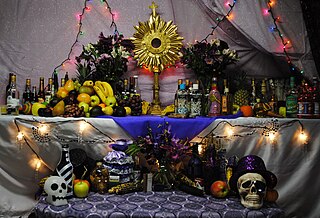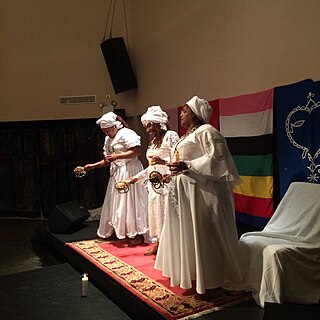
Loa are the spirits of Haitian Vodou and Louisiana Voodoo. They are also referred to as "mystères" and "the invisibles" and are intermediaries between Bondye —the Supreme Creator, who is distant from the world—and humanity. Unlike saints or angels, however, they are not simply prayed to, they are served. They are each distinct beings with their own personal likes and dislikes, distinct sacred rhythms, songs, dances, ritual symbols, and special modes of service. Contrary to popular belief, the loa are not deities in and of themselves; they are intermediaries for, and dependent on, a distant Bondye.

Ayida-Weddo is a loa of fertility, rainbows, wind, water, fire, and snakes in Vodou, especially in Benin and Haiti. Ayida-Weddo is known as the "Rainbow Serpent". Variants of Ayida-Weddo's name include Aida-Weddo, Ayida-Wedo, Aido Quedo, and Aido Hwedo.

Damballa, also spelled Damballah, Dambala, Dambalah, among other variations, is one of the most important of all loa, spirits in Haitian Vodou and Louisiana Voodoo traditions. He is portrayed as a great white serpent, originating in the city of Wedo in modern-day Benin. Damballa is said to be the Sky Father and the primordial creator of all life, or the first thing created by Gran Met. In those Vodou societies that view Damballa as the primordial creator, he created the cosmos by using his 7,000 coils to form the stars and the planets in the heavens and to shape the hills and valleys on earth. In others, being the first thing created by God, creation was undertaken through him. By shedding the serpent skin, Damballa created all the waters on the earth. As a serpent, he moves between land and water, generating life, and through the earth, uniting the land with the waters below. Damballa is usually syncretized with either Saint Patrick or Moses. He is counted among the Rada lwa.

Ayizan is the loa of the marketplace and commerce in Vodou, especially in Haiti.

Baron Samedi, also written Baron Samdi, Bawon Samedi or Bawon Sanmdi, is one of the loa of Haitian Vodou. Samedi is a loa of the dead, along with Baron's numerous other incarnations Baron Cimetière, Baron La Croix and Baron Kriminel. He is syncretized with Saint Martin de Porres.

Maman Brigitte also written Gran Brigitte, Grann Brigitte, Manman, Manman Brigit, and Maman Brijit, is a death loa and the consort of Baron Samedi in Haitian Vodou. She drinks rum infused with hot peppers and is symbolized by a black rooster. Like Samedi and the Ghede, she is foul-mouthed. She is also the adoptive mother of Ghede Nibo.
Maîtresse Délai is the patron loa of tambourine players in Vodou. She walks with the tambourine player.
Marassa Jumeaux are the divine twins in Vodou. They are children, but more ancient than any other loa. "Love, truth and justice. Directed by reason. Mysteries of liaison between earth and heaven and they personify astronomic-astrological learning. They synthesize the vodou Loa as personification of divine power and the human impotence. Double life, they have considerable power which allow them manage people through the stomach. They are children mysteries."

Simbi is a large and diverse family of serpents also known as loa in Haitian Vodou. Some names for the Simbi loa include Simbi Dlo, Simbi Makaya, Simbi Andezo, and Gran Simba. Traditionally in their Kongo context, they are all associated with water, but in the Haitian Vodoun context they have wide-ranging associations. For example, Simbi Makaya is a great sorcerer and served in particular in the Sanpwel secret societies. Simbi Anpaka is a loa of plants, leaves, and poisons.
Haitian Vodou is a syncretic mixture of Roman Catholic rituals developed during the French colonial period, based on traditional African beliefs, with roots in Dahomey, Kongo and Yoruba traditions, and folkloric influence from the indigenous Taino peoples of Haiti. The Loa, or spirits with whom Vodouisants work and practice, are not gods but servants of the Supreme Creator Bondye. In keeping with the French-Catholic influence of the faith, vodousaints are for the most part monotheists, believing that the Loa are great and powerful forces in the world with whom humans interact and vice versa, resulting in a symbiotic relationship intended to bring both humans and the Loa back to Bondye. "Vodou is a religious practice, a faith that points toward an intimate knowledge of God, and offers its practitioners a means to come into communion with the Divine, through an ever evolving paradigm of dance, song and prayers."
Loko is a loa, patron of healers and plants, especially trees in the Vodou religion. He is a racine (root) and a rada loa. Among several other loa, he is linked with the poteau mitan or center post in a Vodou peristyle.

A veve is a religious symbol commonly used in different branches of Vodun throughout the African diaspora such as Haitian Vodou. Veves should not be confused with the patipembas used in Palo, nor the pontos riscados used in Umbanda and Quimbanda since these are separate African religions. The veve acts as a "beacon" for the Loa, and will serve as a loa's representation during rituals.

Homosexuality in Haitian Vodou is religiously acceptable and homosexuals are allowed to participate in all religious activities. However, in countries with large Vodou populations, some Christian influence may have given homosexuality a social stigma, at least on some levels of society.
A bokor (male) or caplata (female) is a Vodou witch for hire who is said to serve the loa "with both hands", practicing for both good and evil. Their black magic includes the creation of zombies and the creation of 'ouangas', talismans that house spirits.
Petro, sometimes as Pethro, is a family of loa (spirits) in Haitian Vodou religion. The story is that they originated in Haiti, under the harsh conditions of slavery. The term petro can also refer to a drum used in the music of Haiti. "Petro" loas are often considered to be "angry" or demon loa, used in "black magic". They are the "newer" loa that can relate to the harsh, traumatic conditions that slaves had to endure.

A mambo is a priestess in the Haitian Vodou religion. Haitian Vodou's conceptions of priesthood stem from the religious traditions of enslaved people from Dahomey, in what is today Benin. For instance, the term mambo derives from the Fon word nanbo. Like its West African counterpart, Haitian mambos are female leaders in Vodou temples who perform healing work and guide others during complex rituals. This form of female leadership is prevalent in urban centers such as Port-au-Prince. Typically, there is no hierarchy among mambos and houngans. These priestesses and priests serve as the heads of autonomous religious groups and exert their authority over the devotees or spiritual servants in their hounfo (temples). Mambos and houngans are called into power via spirit possession or the revelations in a dream. They become qualified after completing several initiation rituals and technical training exercises where they learn the Vodou spirits by their names, attributes, and symbols. The first step in initiation is lave tèt, which is aimed at the spirits housed in an individual's head. The second step is known as kouche, which is when the initiate enters a period of seclusion. Typically, the final step is the possession of the ason, which enables the mambo or houngan to begin their work. One of the main goals of Vodou initiation ceremonies is to strengthen the mambo's konesans—knowledge that determines priestly power.
Rada is a major family of loa in Haitian Vodou.
Vodou drumming and ceremonies are inextricably linked in Haiti. While drumming does exist in other contexts in the country, by far the richest traditions come from this distinctly Haitian religion. As such, before one can come to play, appreciate, and understand this music one should view it in its religious context. Haitian Vodou is a henotheistic religion, although viewed by many Haitians as a cultural practice, widely practiced in the country of Haiti. Vodou as practiced in urban centres in Haiti and some cities in North America is a ritualistic faith system that involves ceremonies that consist of singing, drumming and dancing. While certain aspects of this religion may share the same roots, it is completely contrary to the stereotype of black magic, witch doctors, pins in dolls, and zombies portrayed by New Orleans style Voodoo.
Anaisa Pye is a popular loa within religion in the Dominican Republic. She is considered the patron saint of love, money, and general happiness within the religion in the Dominican Republic 21 Divisions.

Dominican Vudú, also known as Las 21 Divisiones, is a syncretic religion of Caribbean origin which developed on the island of Hispaniola.








